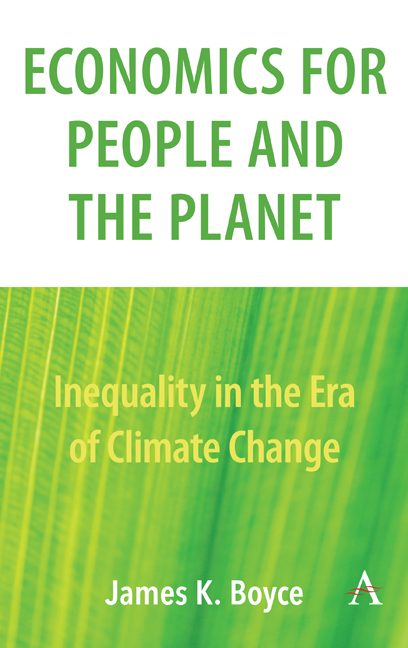Book contents
- Frontmatter
- Contents
- List of Illustrations
- Acknowledgements
- Part I Rethinking Economics and the Environment
- Chapter 1 Limits to Growth–of What?
- Chapter 2 The Twin Tragedies of Open Access
- Chapter 3 Pursuing Profits–or Power?
- Chapter 4 Rent in a Warming World
- Chapter 5 Universal Assets for Universal Income
- Chapter 6 Universal Basic Income: Six Questions
- Chapter 7 Environmentalism's Original Sin
- Chapter 8 Rethinking Extinction
- Part II Environmental Injustice
- Part III Climate Policy
- Notes
- Publication History
- Index
Chapter 8 - Rethinking Extinction
from Part I - Rethinking Economics and the Environment
Published online by Cambridge University Press: 12 February 2019
- Frontmatter
- Contents
- List of Illustrations
- Acknowledgements
- Part I Rethinking Economics and the Environment
- Chapter 1 Limits to Growth–of What?
- Chapter 2 The Twin Tragedies of Open Access
- Chapter 3 Pursuing Profits–or Power?
- Chapter 4 Rent in a Warming World
- Chapter 5 Universal Assets for Universal Income
- Chapter 6 Universal Basic Income: Six Questions
- Chapter 7 Environmentalism's Original Sin
- Chapter 8 Rethinking Extinction
- Part II Environmental Injustice
- Part III Climate Policy
- Notes
- Publication History
- Index
Summary
In the space of a single century, the passenger pigeon went from being the world's most abundant bird to complete extinction. What happened to it–and to us?
A little more than a hundred years ago, a bird named Martha, the last surviving passenger pigeon, died in the Cincinnati Zoo. Her death was remarkable in the annals of extinction not only because we know its precise date– September 1914–but also because only decades earlier the passenger pigeon had been the most abundant bird on Earth. Martha's demise helped to transform American beliefs about our relationship with nature, and the bird became an icon in the environmental movement, which was emerging just as she died.
Among the many billions of passenger pigeons who predeceased Martha was her cage mate, George, who died in 1910. The pair were named after Martha and George Washington. In the century that separated the first First Lady from the last passenger pigeon, America's economy went through a profound transformation. The country's population increased more than tenfold, and average income more than quadrupled. Only 6 per cent of Americans lived in cities when Martha Washington died, in 1802. In 1914, the number was closer to 50 per cent. The passenger pigeon's extinction was bound up with these changes, and what happened to the bird tells us much about what happened–and is still happening–to us.
Tourists came from near and far to see Martha after George's death. The aerial displays of passenger pigeons had astonished their parents and grandparents, but at the zoo they found a pathetic creature with ‘drooping wings, atremble with the palsy of extreme old age’, in the words of a reporter. To dissuade the public from flinging sand at her to make her move, the zookeepers roped off her cage.
After her death, Martha was frozen in a 300- pound block of ice and shipped to the Smithsonian Institution, in Washington. Her internal organs were removed and preserved in the museum's ‘wet collections’, and her skin was stuffed and mounted for display. In 1977, when the Cincinnati Zoo opened a passenger-pigeon memorial, Martha was flown in for the dedication ceremony. She travelled first class.
- Type
- Chapter
- Information
- Economics for People and the PlanetInequality in the Era of Climate Change, pp. 27 - 36Publisher: Anthem PressPrint publication year: 2019



